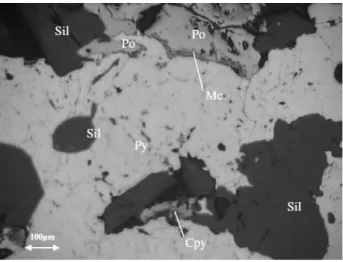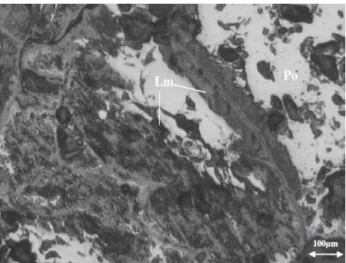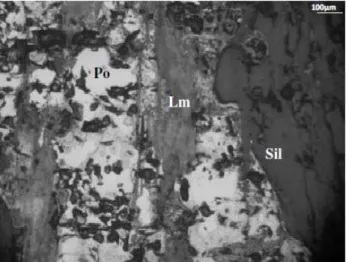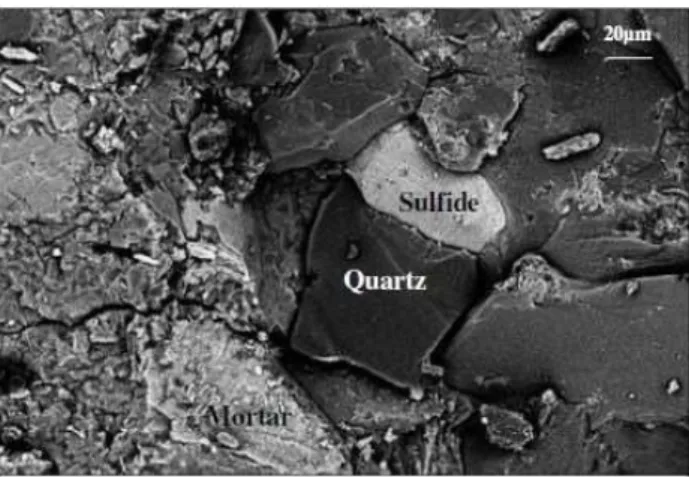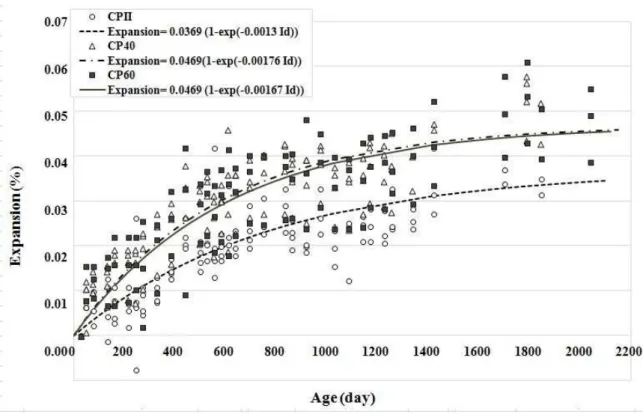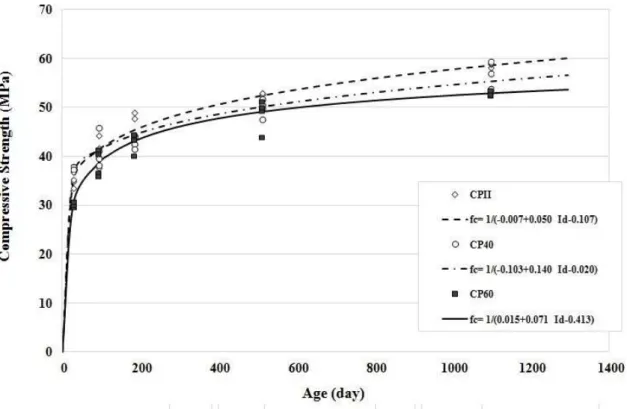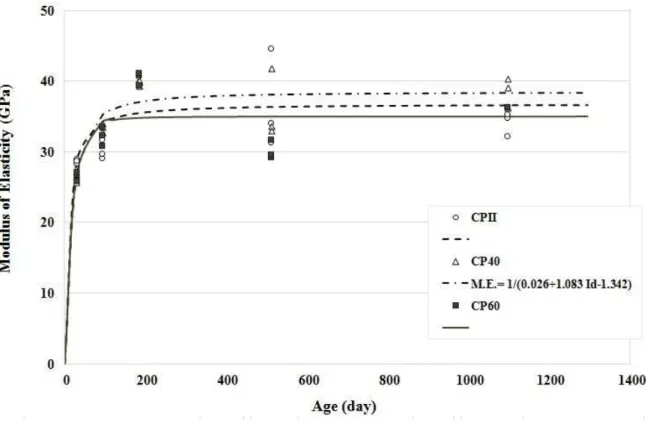ISSN 1517-7076 artigo e11851, 2017
Autor Responsável: Maria de Jesus Gomides Data de envio: 19/07/2016 Data de aceite: 17/10/2016
10.1590/S1517-707620170003.0185
Efeito da incorporação de agregados com alto
teor de sulfetos nas propriedades mecânicas
e microestruturais de concretos com
cimento de escória
Effect of the incorporation of aggregates with high
sulfide content on the mechanical and
microstructural properties of concrete
with slag cement
Maria de Jesus Gomides 1, Denise Coitinho Carpena Dal Molin 2, João Henrique da Silva Rêgo 3
1
Federal Institute of Education, Science and Technology of Goiás, Câmpus Aparecida de Goiânia. NUPECOCI leader. Av. Universitária Vereador Vagner da Silva Ferreira, Qd-1, Lt 1-A – Parque Itatiaia. 74968-755. Aparecida de Goiâ-nia/GO - Brazil.
email: ziza.gomides@gmail.com; maria.gomides@ifg.edu.br 2
Federal University of Rio Grande do Sul, School of Engineering, Department of Civil Engineering. Av. Osvaldo Aranha, 99, 3 andar. Cidade Baixa. 90035-190. Porto Alegre/ RS - Brazil.
email: dmolin@ufrgs.br 3
University of Brasília, Environmental and Civil Engineering Department. Campus Universitário Darcy Ribeiro, Asa Norte, 70910-900, Brasília/DF - Brazil.
email: jhenriquerego@unb.br
ABSTRACT
The mineralogical change in the sulfides present in many aggregates can affect their stability, which may undermine the performance of the concrete. This is a complex process and there is limited research in this area. In this study, we examined the influence of aggregates containing a high sulfide content on the perfor-mance of concrete containing slag cement. The sulfides present in the aggregates were initially identified and quantified. The changes at the microstructural level of the concrete caused by the sulfide-containing aggre-gates were then examined. These included volume changes, as well as their effect on the compressive strength and modulus of elasticity. The results show that slag cement does not reduce expansion, and it is this expansion that affects the mechanical properties of concrete.
Keywords: sulfide; oxidation; expansion; strength; concrete.
1. INTRODUCTION
Economic and environmental factors are very important when choosing the construction materials, especially for large constructions, as for instance hydraulic structures. In most cases, to build these structures a large volume of rock material from different extraction processes is discarded into the environment. The ideal situ-ation therefore is to use this debris as a constituent material of concrete or as part of the construction. To car-ry this out, however, it is crucial to assure its quality, as well as the durability of the concrete. Therefore, the rocks should be studied in-depth and the alteration process of the sulfides in the aggregates from these rocks must be investigated prior to their use in the concrete.
fragment-ed aggregate can be considered a typical and evident feature of the aggregate’s expansion, a phenomenon that can undermine the durability of concrete.
The second mechanism is related to the concrete subjected to internal sulfate attack. According to a number of different studies [1, 2, 7], aggregates containing sulfide minerals can become an internal source of sulfate ions. It is known that the presence of sulfate ions in the pore solution of concrete can promote the de-velopment of chemical reactions between these aggressive ions, released by the aforementioned sulfide alter-ation, and the cement paste composition, which may result in the formation of expansive and deleterious products that are typical of sulfate attack known as ettringite, gypsum and thaumasite [7, 8, 9].
Regarding the main symptoms that characterize a concrete structure attacked by internal sulfide-containing aggregates are mapping and/or oriented cracks on the concrete surface; rust stains on the concrete surface; superficial white efflorescence; expansion due to the formation of hydrated iron sulfates and iron hydroxides; pH reduction of concrete due to the consumption of calcium hydroxide in the system; expansion due to the formation of ettringite and swelling and disaggregation of the concrete due to the weakening of the cement’s hydration products by the gypsum formation, which is accompanied by moderate expansion.
Slag is widely used as a mineral addition for cement in hydraulic structures. It is particularly suitable for use in structures such as dams as it improves some properties of cement by reducing heat of hydration and also mitigating alkali-aggregate reaction. The objective of this experimental program was to assess the influ-ence of the sulfides on the mechanical properties of concretes prepared with referinflu-ence cement (referred to in Brazil as CP II F-32) and cements with mass replacement of 40% and 60% of slag and aggregates of quartz-muscovite-schist with high sulfide content.
2. MATERIALS E METHODS
The materials used in the preparation of the concrete test specimens were:
Ordinary Portland cements with carbonate filler (6% to 10%) – CP II-F-32 Brazilian type (CPII),
CP II with partial replacement by 40% of slag, in mass (CP40);
CP II with partial replacement by 60% of slag, in mass (CP60).
Quartz-muscovite-schist litotype aggregate containing sulfides (pyrrhotite, pyrite and chalcopyrite), maximum size of 19 mm;
Artificial sand from quartz-muscovite-schist containing sulfides;
Natural quartz sand.
The cements used in the experimental program were characterized by physical and chemical analyses and the main features are presented in Tables 1 and 2. Table 3 shows the chemical composition of blast fur-nace slag and Table 4 shows the physical characterization results of the coarse and fine aggregate used.
Table 1: Physical characteristics of cementitious materials (%).
Cementitious Material Density (kg/m³)
Blaine Fineness
(cm²/g)
Setting time (hour:min)
Compressive Strength (MPa)
Initial Final 3days 7days 28days
CPII 3.09 3540 02:10 03:20 23.6 27.9 34.4
CP40 2.99 3161 02:50 04:20 15.4 23.5 40.0
Table 2: Chemical characteristics of cementitious materials (%).
Cementitious
Material SiO2 Al2O3 Fe2O3 CaO MgO Na2O K2O NaTotals 2Oeq
Loss on ignition
SO3 Lime Free Insoluble residue
CPII 19.44 5.48 3.73 62.88 1.39 0.24 0.41 0.51 3.13 2.52 2.23 0.93
CP40 25.91 7.79 2.66 54.48 3.93 0.28 0.45 0.49 2.45 1.93 1.30 0.72
CP60 29.11 9.05 2.40 50.54 4.82 0.23 0.55 0.59 1.14 1.38 0.90 0.52
Note: Na2Oeq = 0.658K2O + Na2O.
Table 3: Chemical characteristics of blast furnace slag (%).
Chemical
composition SiO2 Al2O3 Fe2O3 CaO MgO Na2O K2O
Na2Oeq Totals Loss on ignition SO3 Free Lime Insoluble residue
Blast furnace slag
35.04 12.43 0.16 41.58 8.68 0.31 0.55 0.67 0.31 0.12 - -
Table 4: Coarse and fine aggregate characteristics.
Characteristics Coarse Aggregate
Maximum Size of 19 mm
Artificial Fine Aggregate
Natural Fine Aggregate
Specific gravity (kg/m3) 2.74 2.79 2.62
Absorption (%) 0.6 0.2 0.4
Fineness Modulus (M.F.) 6.41 2.69 2.99
Content of powdered material (%) - 17.48 0.99
Los Angeles (%) 25% - -
The concretes studied had the following mix design: 467 kg/m³ of cement, 1018 kg/m³ of coarse ag-gregate containing sulfides [maximum size of 19 mm], 183 kg/m³ of artificial sand containing sulfides, 495 kg/m³ of natural sand, water/cement ratio equal to 0.45 and slump of about 90 mm. The prismatic and cylin-drical test specimens cast for the experimental program were stored in a moist room with the temperature kept at 23oC ± 2oC and the relative humidity higher than 90%.
Moreover, before using the aggregates in the concrete preparation, the polished sections of the crushed aggregate (powder) from profile cuts were analyzed by reflected light optical microscopy using an Axioskop 40 Pol Zeiss optical microscope and a Leica DFC280 digital camera model with QwinThus image software. A qualitative analysis was initially performed to identify the mineralogical composition, and a quantitative analysis to determine the percentage of sulfide minerals in the section representing the analyzed aggregate, obtained through a modal analysis.
All concrete prismatic specimens were visually inspected in order to determine the presence of typical symptoms of unstable sulfides contained in the aggregates used in the composition of the system, over time.
The cylindrical specimens were used to determine the compressive strength and modulus of elasticity of the concretes at 28, 90, 182, 510, and 1095 days of age, respectively, in accordance with the Brazilian standard ABNT NBR 5739:2007 [11], similar to ASTM C-39/2012 [12] and the standard ABNT NBR 8522:2008 [13]. After the completion of this test, samples of aggregates and mortars were extracted from the concretes at specific ages. The aggregates were subjected to microstructural analysis using optical micro-scope in order to investigate and assess the mineralogical changes, specifically the sulfides contained in the aggregates extracted from the investigated concretes, after their oxidation.
X-ray diffraction and scanning electron microscopy analyses (Siemens D5000 X-Ray diffractometer and SEM Leica S440i) were performed on the concrete mortars to identify deleterious neoformed products resulting from the alteration process of the sulfides in the aggregates used in the concretes.
3. RESULTS
The results concerning the main physicochemical alterations of the aggregate’s microstructure containing sulfides and the expansion, compressive strength and modulus of elasticity of the concretes over time were presented.
3.1 Optical Microscopy
The sulfide-containing aggregate was characterized as quartz-muscovite-schist by transmitted light optical microscopy before being used in the concretes. It is primarily composed of 60-65% of quartz, 30% of mus-covite, < 10% of opaque minerals and carbon matter, and <5% of garnet, biotite, and chlorite. Sulfides are opaque minerals which can only be identified by reflected light. Thereby, by means of reflected light optical microscopy, it was possible to identify the opaque and quantify the sulfides in the aggregates under study. The quantification of the sulfides in the polished sections of the aggregate powder provided an average of 3.9% total sulfides and of that total, 3.3% correspond to pyrrhotite (Fe1-xS), 0.3 % to pyrite (FeS2), 0.2% to marcasite (FeS2), and 0.1% to chalcopyrite (CuFeS). Figure 1 shows the sulfide minerals, oxides, and trans-parent minerals such as silicates that were identified.
Figure 1: Photomicrograph of a large pyrrhotite (Po) crystal with incipient alteration to marcasite (Mc) in contact with pyrite (Py), inclusion of chalcopyrite (Cpy) and intergrowth with silicate (Sil).
Figure 2: Photomicrography of the aggregate containing sulfides extracted from the CPII at 28 days: Pyrrhotite (Po) with intense oxidation to limonite (Lm) from the fractures.
Figure 3: Photomicrography of the aggregate containing sulfides extracted from the CPII at 90 days: Pyrrhotite (Po) with intense oxidation to limonite (Lm) from the fractures.
Figure 5: Photomicrography of the aggregate containing sulfides from the CP 40 at 90 days: Pyrrhotite (Po) changing to marcasite and (Mc) and limonite (Lm).
Figure 6: Photomicrograph of aggregate containing sulfides extracted from CP60 at 1095 days: Large fragment of pyr-rhotite (Po) changing to marcasite (Mc) and limonite (Lm) from the internal fractures.
Ultimately, the analysis enables confirming that the pyrrhotite is the most reactive mineral in the sys-tem, hence the one primarily responsible for the changes observed in the aggregates [5,7]. Furthermore, it shows that the presence of moisture is essential to accelerate the alteration process of the iron sulfides [14].
To corroborate the aforementioned statements, the visual and tactile tests carried out on the concretes revealed that the inside of the concretes was wet. In addition, an unpleasant rancid odor similar to the smell of sulfur was detected after the rupture of the concrete. This is due to the release of hydrogen sulfide (H2S), typical of the oxidation of sulfide minerals.
Figure 7: Photomicrograph of the concrete mortar extracted from the CP60: interface mortar/aggregate containing sul-fides. Presence of cracks and fragmentation of both systems.
3.2 Microstructural Analyses: X-Ray Diffraction and Scanning Electron Microscopy
The X-ray diffraction and scanning electron microscopy analyses performed on the mortars extracted from the investigated concretes were also important as it helped identify the products formed over time due to the alteration process of the sulfides found in the aggregates.
The main crystalline products identified were portlandite (calcium hydroxide), ettringite, and gypsum. These products were found in all concretes prepared with CPII, CP40 and CP60, virtually at all ages studied (28, 90, 182 and 1095 days). It is well known that ettringite and gypsum can be found in hydrated cement paste. However, these products may also be indicative of intrinsic changes in concrete due to deleterious re-actions between the phases of cement paste and the aggressive ions (SO42- and H+) released, as it is known, during the alteration process of the sulfides [4, 5, 6, 8, 17].
Numerous studies have shown that ettringite and gypsum are typical products of traditional sulfate at-tacks, which are responsible for causing the appearance of several pathological events that can lead to the complete deterioration of concrete structures. The formation of ettringite crystals can trigger the expansion of concrete and consequently the cracking of this material [14, 18]. With regards to gypsum, it can promote the progressive reduction of compressive strength, stiffness, and loss of concrete mass due to the weakening or breakdown of the hydration products on cement paste [18, 19].
3.3 Expansion
Figure 8: Expansion: curves fitting the experimental results determined for each cast concrete.
3.4 Compressive Strength
Figure 9: Compressive strength: curves adjusted to the experimental results for each cast concrete.
In order to check whether there is homogeneity of concrete in relation to the type of binder, the Duncan test with multiple comparisons of means was performed. It was found that the experimental results for each concrete resulted in very close averages, but even so, two distinct groups were obtained. The first group (concrete CP40 and CPII), showed higher mean compressive strength values, around 9%, in comparison with the mean values obtained for the second group (concrete CP60). However, these results require caution. The increased CPII compression strength until 1095 days of age was probably due to the increased concentration of formed products, ettringite, in the pores as evidenced by XRD (X ray diffraction) and SEM (scanning electron microscopy). Therefore, the internal attack by sulfates may have only served to increase the mechanical strength of the concrete, i.e., not initiated the critical phase of the attack, considering that the CPII mortars were still dense and with few cracks compared to CP40.
3.5 Modulus of Elasticity
Figure 10: Modulus of elasticity: experimental results and curves adjustments to the experimental results for each indi-vidual prepared.
In order to check whether there is homogeneity of the concretes investigated in relation to the type of binder, the Duncan multiple comparison of means test was performed. According to Duncan’s method, there were no significant differences between the binders used in terms of modulus of elasticity.
4. DISCUSSION
The influence of the main physicochemical alterations of the aggregate’s microstructure containing sulfides on the performance of each concrete studied was assessed.
4.1 Expansion
According to CASANOVA et al. [15], the formation of ettringite crystals can promote a volumetric variation in the sulfide mineral within the system equal to 172.19cm3/mol of sulfate. In the case of gypsum, the varia-tion is much lower than that of ettringite, on the order of 41.63 cm3/mol of sulfate. To confirm that the ex-pansion observed in the concretes is related to the formation of ettringite and gypsum, the XRD and SEM analyses carried out substantiated the presence of both products.
A kinetic model to quantify the expansion due to the iron sulfide oxidation, as well as the secondary ettringite formation in the concrete, was proposed in 2013 [22]. The model allows a direct prediction of the expansion generated by the internal sulfate attack, taking into account the physical and chemical characteris-tics of the concrete and of the aggregate.
The expansion mechanism caused by the formation of deleterious products in the internal sulfate at-tacks can be summarized as follows: In the early stages, the expansive products ettringite and/or gypsum are formed in the voids and pores of the paste, but do not cause internal tensions. Over time, these products begin to fill the voids and pores of the paste, thus reducing their ability to be accommodated in the internal porous structure of the concrete paste. As a result, internal stresses produced in the material can begin, which are supported by the preserved regions of the cement paste. From the moment the preserved region can no longer withstand the tensile strength generated by the products formed, the expansion phenomenon begins to devel-op in the concrete [4].
not observed in concrete CPII. Therefore, it is concluded that the internal microstructure of concrete prepared with slag cement (CP40 and CP60) contributed to the expansion developing faster and more intensely in these concretes, reaching the value of 0.04% after 1029 days of age.
It is also reported that after approximately 1,900 days (more than 5 years under study) the expansions tend to stabilize, which is likely due to the consumption of the aluminate phases of the cement paste, includ-ing the reduction of the amount of sulfate ions released by the oxidation of the sulfides, given that these change over time. Therefore, these factors may have contributed to the reduction of the dynamics of the ex-isting process [4]. It is believed that the main deleterious effect resulting from the expansion, i.e., the for-mation of microcracks in the system, can contribute to this stability as new “spaces” are generated within the paste, which can cause the reduction in the intensity of the expansion in a given period of time. However, over time these “spaces” can also be filled by new products that will be formed when there are sulfate ions in the system; thus, the expansion process will continue. Furthermore, these microcracks can cause the appear-ance of other pathological phenomena which, together with the internal attack by sulfates, can accelerate the deterioration of the concrete [14].
4.2 Compressive Strength
In the situation studied, the internal sulfate attack in CP40 at 28 days of age promoted a "seemingly" benefi-cial effect, i.e., a resistance gain. This probably resulted from the formation of ettringite and gypsum, prod-ucts identified by XRD and SEM. To confirm the previous statement, the performance of CP60, which con-tains a higher content of slag (60%), was analyzed. It appears that the concrete always had the lowest re-sistance values, probably a consequence of the lower concentration of calcium hydroxide in the system, lead-ing to the sulfate ion attack in the C-S-H phases, which are responsible for paste strength. This is most appar-ent with the visual inspections performed on the external surfaces of the concrete prepared with slag, which is found in the worst pathological manifestations resulting from this deleterious phenomenon; namely, the dis-integration or deterioration of the material, which is intensified in the CP60.
The aforementioned results corroborate the fact that the compressive strength test may not be the most appropriate for evaluating the deterioration and internal attack by sulfates [4, 24]due to the alteration of the sulfides, since this property might even be favored, depending on the microstructure and stage of the attack.
4.3 Modulus of Elasticity
The aforementioned analyses allow us to state that, regardless of the binder used, the modulus of elasticity was compromised by the high concentration of sulfides in the aggregate. Two phenomena may have possibly contributed to this behavior: First, the internal attack by sulfates, which resulted in the formation of products at the paste/aggregate interface. Second, the physical and mineralogical changes in the aggregate caused by the oxidation of sulfides over time, as detected by images via optical microscopy. However, jointly these two phenomena have not yet been able to significantly affect the modulus of elasticity, i.e., not sufficiently, dur-ing the evaluation period, to promote the reduction or decrease in this property, as would be expected for expansive reactions [25]. This justifies the assertion in the curves relating to the setting of each individual modulus, i.e., the stabilization of this property after 182 days. Moreover, the intrinsic alterations have to be taken into consideration due of the oxidation process of sulfides, which is not yet known.
5. CONCLUSIONS
Pathological manifestations (specifically, white efflorescence spots, spalling, and disintegration) resulted from the sulfide oxidation process, which became more intense with increasing content of slag cement used to partially replace the reference binder (CP II), i.e., CP40 and CP60 in concrete. In this context, these con-cretes, since approximately 4 years of age, were already brittle and powdery, reaching a breakdown state af-ter 5 years.
The compressive strength test was not found to be the most appropriate for evaluating an internal sul-fate attack due to sulfide oxidation, as the "apparently" beneficial effect obtained, namely the growth of this property, over time, can generate a false interpretation of concrete performance.
Typical elastic modulus results for the concrete investigated revealed that the oxidation of sulfides in-terfered intrinsically, but also varied for this property over time, probably due to the heterogeneity of the oxi-dation phenomenon.
6. ACKNOWLEDGMENTS
The authors wish to express their gratitude to the research and development program of ANEEL (Nacional Electric Energy Agency), engineer Nicole Pagan Hasparyk and Eletrobrás Furnas, in Goiânia, Brazil, for the financial and technical support for this research.
7. BIBLIOGRAPHY
[1] CHICHÓN, J.S., AYORA, C., AGUADO, A., et al., “Influence of Weathering of Iron Sulfides Contained in Aggregates on Concrete Durability”, Cement and Concrete Research, v. 25, n. 6, pp. 1264-1272, 1995. [2] AGUADO, A., AGULLÓ, L., CAROL, I., et al., “Análisis del comportamiento estructural del hormigón: de la micro a la macro estructura - Aplicación al caso de presas”, Hormigón y Acero, n. 233, pp. 145-158, 2004.
[3] TAGNIT-HAMOU, A., SARIC-CORIC, M., RIVARD P. “Internal deterioration of concrete by oxidation of pyrrhotitic aggregates”, Cement and concrete research, v. 35, n. 1, pp. 99-107, 2005.
[4] GOMIDES, M. J. Investigação de agregados contendo sulfetos e seus efeitos sobre a durabilidade do concreto, [Research about Aggregates containing sulfides and their effects on the durability of concrete], Tese de D.Sc, Postgraduate Program in Engineering/Federal University of Rio Grande do Sul (UFRGS), Porto Alegre, Brazil, 2009.
[5] SCHMIDT, T., LEEMANN, A., GALLUCCI, E., et al., “Physical and microstructural aspects of iron sulfide degradation in concrete”, Cement and Concrete Research, v. 41, n.3, pp. 263–269, 2011.
[6] RODRIGUES, A., DUCHESNE, J., FOURNIER, B., et al., “Mineralogical and chemical assessment of concrete damaged by the oxidation of sulfide-bearing aggregates: Importance of thaumasite formation on reaction mechanisms”, Cement and Concrete Research, v. 42, n. 10, pp. 1336-1347, 2012.
[7] CASANOVA, I., LÓPEZ, C.M., AGUADO, A., et al., “Micro and Mesoscale Modeling of Expansion in Concrete Dams”, In: Proceedings of International Symposium on New Trends and Guidelines on Dam Safety, v. 1, pp. 661-667, ed. L. Berga, Barcelona, 1998.
[8] AYORA, C., CHICÓN, S., AGUADO, A., et al., “Weathering of Iron Sulfides and Concrete Alteration: Thermodynamic Model and Observation in Dams from Central Pyreness, Spain”, Cement and Concrete Research, v. 28, n. 9, 1223-1235, 1998.
[9] IRASSAR, E. F., BONAVETTI, V. L., MENÉNDEZ, G. “Cementos con Material Calcáreo: Formación de Thaumasita por Ataque de Sulfato”, Revista de la Construcción, v. 9, n. 1, pp. 63 – 73, 2010.
[10] AMERICAN SOCIETY FOR TESTING AND MATERIALS (ASTM): Standard practice for use of apparatus for the determination of length change of hardened cement paste, mortar, and concrete, ASTM C-490, West Conshohocken, 2011.
[11] ASSOCIAÇÃO BRASILEIRA DE NORMAS TÉCNICA (ABNT): Concreto - Ensaios de compressão de corpos-de-prova cilíndricos, [Concrete – Compression test of cylindric specimens – Method], NBR 5739, Rio de Janeiro, 2007.
[12] AMERICAN SOCIETY FOR TESTING AND MATERIALS (ASTM): Standard test method for compressive strength of cylindrical concrete specimens, ASTM C 39/C 39M, West Conshohocken, 2012. [13] ASSOCIAÇÃO BRASILEIRA DE NORMAS TÉCNICA (ABNT): Concreto - Determinação do módulo estático de elasticidade à compressão, NBR 8522, Rio de Janeiro, 2008.
[14] GOMIDES, M. J., CINCOTTO, M. A., HASPARYK, N. P., et al., “Study of aggregates with sulfides in cement composites”, IBRACON Materials Journal, vol. 3, pp. 29-38, 2007.
[16] PEREIRA, E., PORTELLA, K. F., BRAGANÇA, M. D. G. P., et al., “Oxidação da pirita e seus efeitos em argamassas de cimento Portland sujeitas ao ataque por sulfatos de origem interna [Pyrite Oxidation and its effects on Portland cement mortars subject to internal sulfates attack (ISA)]”, Revista Matéria, v. 21, n. 2, pp. 342– 354, 2016.
[17] MA, Y., LIN, C., “Microbial Oxidation of Fe2+
and Pyrite Exposed to Flux of Micromolar H2O2 in Acid-ic Media”, ScientifAcid-ic Reports, 3, 1979, 2013.
[18] MEHTA, P. K., MONTEIRO, P. J. M., Concreto: estrutura, propriedades e materiais, 2 ª ed., São Paulo, IBRACON, 2014.
[19] SANTHANAM, M., COHEN, M. D., OLEK, J., “Mechanism of sulfate attack: a fresh look part 2. Proposed mechanisms”, Cement and concrete research, v. 33, n.3, pp. 341-346, 2003.
[20] AL-AMOUNDI, O.S.B., MASLEHUDDIN, M., SAADI, M.M., “Effect of magnesium sulfate and sodium sulfate on the durability performance of plain and blended cements”, ACI Materials Journal, v. 92, n. 1, pp. 15-24, 1995.
[21] GOMIDES, M. J., Ataque por sulfatos ao concreto compactado com rolo, [Attack of sulfates to roller compacted concrete], Tese de M.Sc, Postgraduate Course in Civil Engineering/Federal University of Goiás (UFG), Goiânia, Brazil, 2001.
[22] OLIVEIRA, I., CAVALARO, H. P. S., AGUADO, A., “New kinetic model to quantify the internal sul-fate attack in concrete”, Cement and Concrete Research, v. 43, pp. 95–104, 2013.
[23] PETROV, N., TAGNIT-HAMOU, A., “Is microcracking really a precursor to delayed ettringite formation and consequent expansion?, ACI Materials Journal, v. 101, n. 6, pp. 442-447, 2004.
[24] IRASSAR, E. F., “Sulfate resistance of blended cement: prediction and relation with flexural strength”, Cement and concrete research, v. 20, n. 2, pp. 209-218, 1990.


